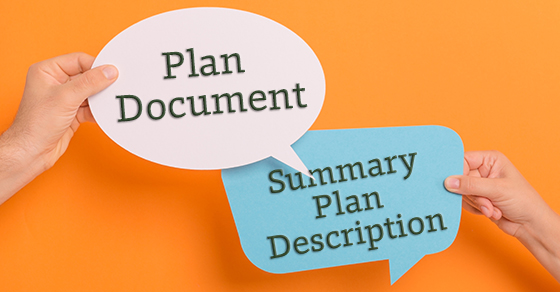What’s the difference between a plan document and an SPD?
August 7, 2018

Most of the health and welfare plans offered by employers today are subject to the Employee Retirement Income Security Act of 1974 (ERISA). Generally, ERISA envisions that employee benefit plans will have both a plan document and a summary plan description (SPD). But, in some cases, a single document may serve both purposes. Let’s look at the difference between the two and under what circumstances they may be combined.
Plan documents
Plans subject to ERISA must be “established and maintained pursuant to a written instrument” called the plan document. It comprehensively sets forth the rights of the plan’s participants and beneficiaries by describing:
• What benefits are available,
• Who’s eligible,
• How benefits are funded,
• Who’s the named fiduciary,
• How the plan can be amended, and
• The procedures for allocating plan responsibilities.
The plan document also guides the plan sponsor and plan administrator in making decisions and executing their responsibilities.
SPDs
ERISA also requires employee benefit plans to have an SPD. A key function of the SPD is conveying plan information in an understandable summary to participants. The SPD must include many specified items, such as:
• Plan-identifying and eligibility information,
• A description of plan benefits and circumstances causing loss or denial of benefits,
• Benefit claim procedures, and
• A statement of participants’ ERISA rights.
The SPD must be written in a manner calculated to be understood by the average plan participant and must be furnished at specific times to specific individuals.
Combining the two
Some health and welfare plans use a single document as both the plan document and SPD. If this approach is taken, the document must comply with both ERISA’s written plan document requirements and its SPD format and content rules.
Some courts and commentators have expressed the view that a combined plan document and SPD is unacceptable because it’s impossible for a document to summarize itself. But at least two appellate courts have approved the combined approach for welfare plans.
Penalties possible
Participants and beneficiaries may request copies of the plan document and the SPD. Failure to furnish the documents within 30 days after the request may expose the ERISA plan administrator (typically the employer) to penalties of up to $110 per day — even if either document was already provided in the normal course, as may be the case with the SPD.
Finally, note that for group health plans a summary of benefits and coverage (SBC) is also required but is separate from and in addition to the plan document and the SPD. For more information, contact us.
© 2018
Get More Articles Like This in Your Inbox
Sign up for our email newsletter and get the latest news sent straight to you.
Questions? Need assistance? We can help!

